Pomelo Fruit
This post may contain affiliate links. Please read the disclosure policy.
Pomelo is the largest citrus fruit and boasts a sweet and mild taste. Here we explain all about the pomelo and how it compares to grapefruit. We also cover health benefits, how to cut pomelo fruit and lots more!
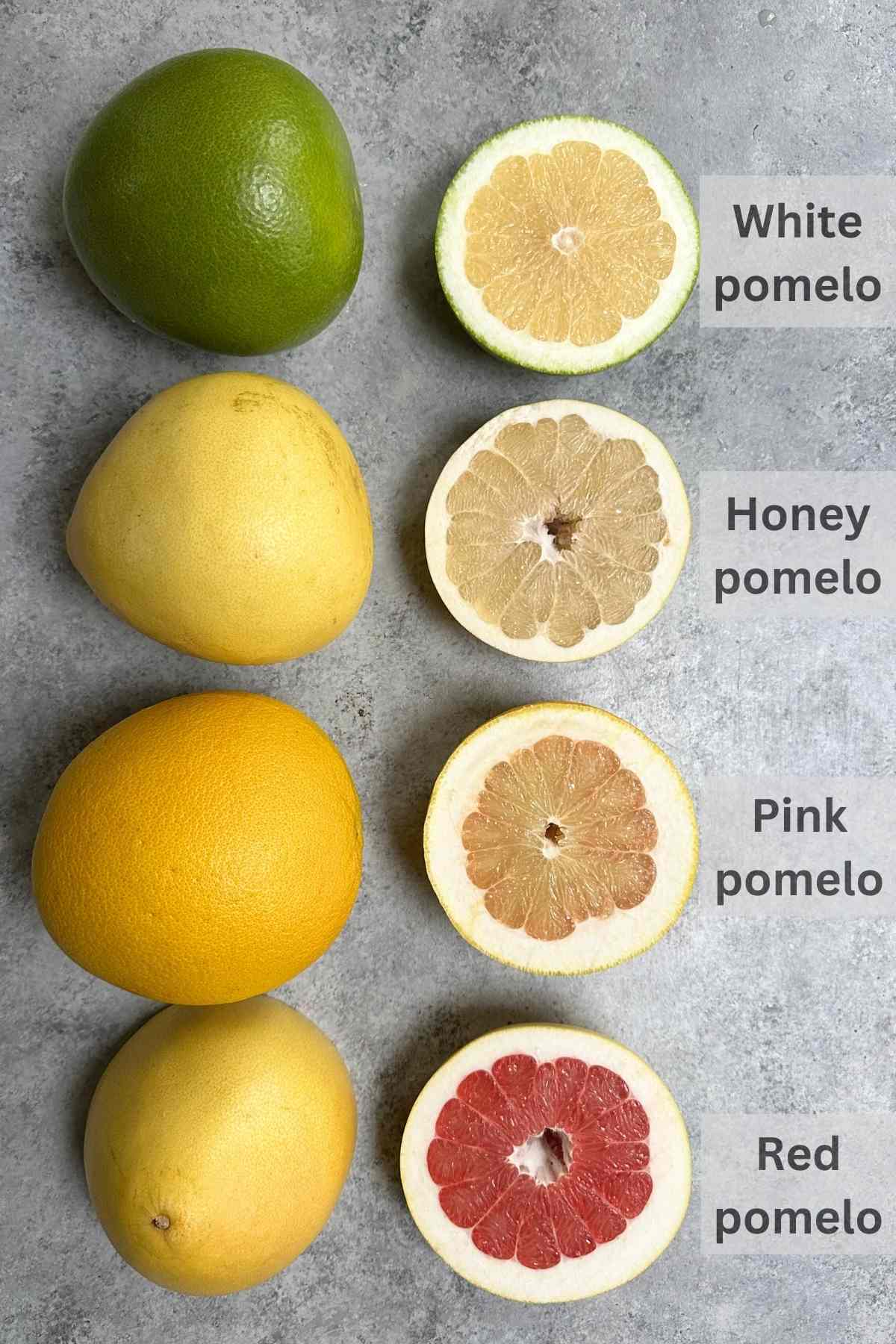
One of my favorite exotic fruits is the pomelo with its pleasant mild flavor and meaty texture. Not only does it make a healthy snack, but it’s great on-the-go with no mess unlike grapefruit. Just peel and enjoy!
What is a Pomelo
Pomelo is the largest of all citrus fruit and can grow up to one foot in diameter! It comes from the Rutaceae family with a scientific name of citrus maxima or citrus grandis. It’s the main ancestor to the common grapefruit.
This fruit is native to Southeast Asia where it has been cultivated for thousands of years. Major producing countries today include China, Vietnam and America (mainly California and Florida). The fruit grows on the pomelo tree, which can reach up to 50 feet in height:
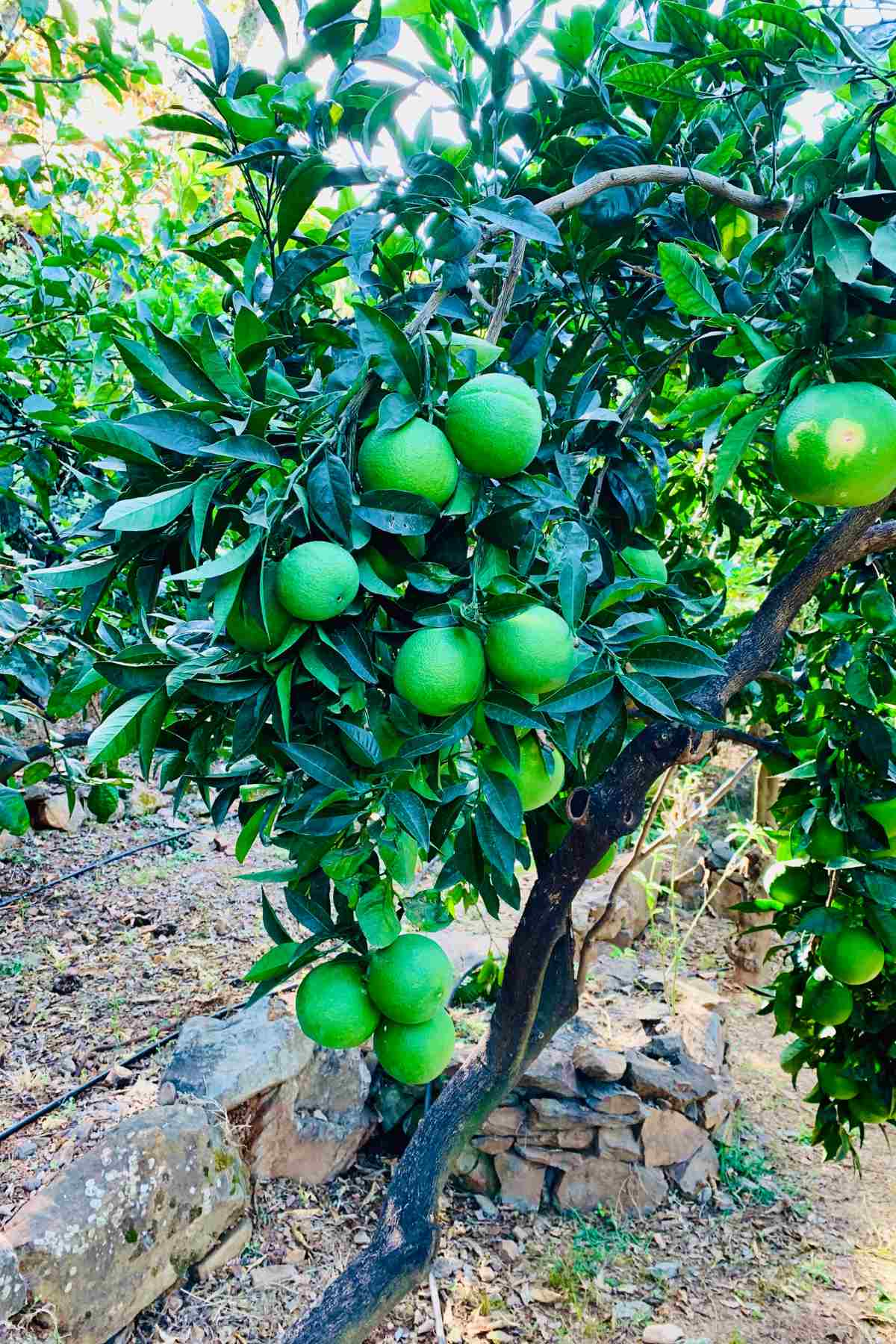
You may see various spellings for this fruit, including pomello, pumelo, pummelo, pamelo and paloma. It also has many names that vary by country with examples being Chinese grapefruit, Asian grapefruit, shaddock, jadong, jambola, chakota, bhogate, suha and lusho.
There main varieties are: 1) white pomelo with white flesh, 2) honey pomelo with pale yellow flesh, 3) pink pomelo with light pink flesh, and 4) red pomelo with ruby-colored flesh. The peel color can vary widely and does not indicate the color of the flesh, so check the label when shopping!
Pomelo season starts in November/December and runs through April/May in the northern hemisphere. However, global production means this fruit is conveniently available year-round.
What Does a Pomelo Taste Like? It has a sweet and mild flavor without the tartness of oranges or the bitterness of grapefruit. The flesh is firm and meaty without being juicy like other citrus. Note that the taste does not vary much by color of the peel or flesh.
Pomelo vs Grapefruit
Fun fact: Did you know that grapefruit is a cross between a pomelo and an orange? That’s right. The grapefruit is actually a hybrid, explaining why it’s larger than an orange but smaller than a pummelo!
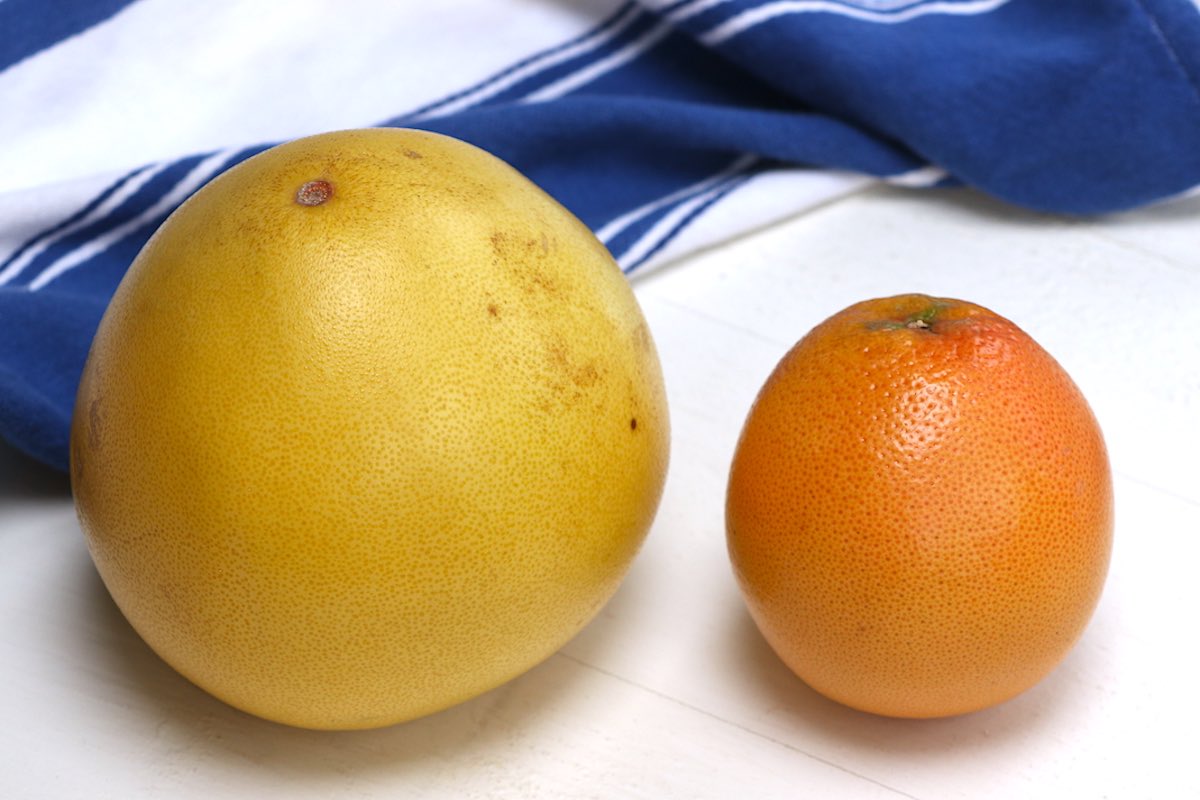
While these two fruits bear some resemblance, they’re actually quite different in appearance and taste. Here’s a comparison of the two:
| Pomelo | Grapefruit | |
| Skin | Green, yellow or orange with a thick peel | Yellow or orange with a thinner peel |
| Shape | Round or oblong | Round |
| Typical diameter | 6 to 10 inches | 4 to 6 inches |
| Typical weight | 2 – 4 pounds | ½ – 1 ½ pounds |
| Taste | Sweeter and mild | Tart and at times bitter |
| Texture | Firm and meaty | Soft and juicy |
Which one is better? Many people enjoy the mild taste of the pomelo, but it’s also larger and more expensive than a grapefruit. Try them both to decide.
Pomelo Grapefruit: I was at Whole Foods one day when they were selling pomelo grapefruit. It was smaller than usual and also juicy and sour. As it turns out, this new offering is a hybrid of pomelo and grapefruit, so check the label carefully before buying!
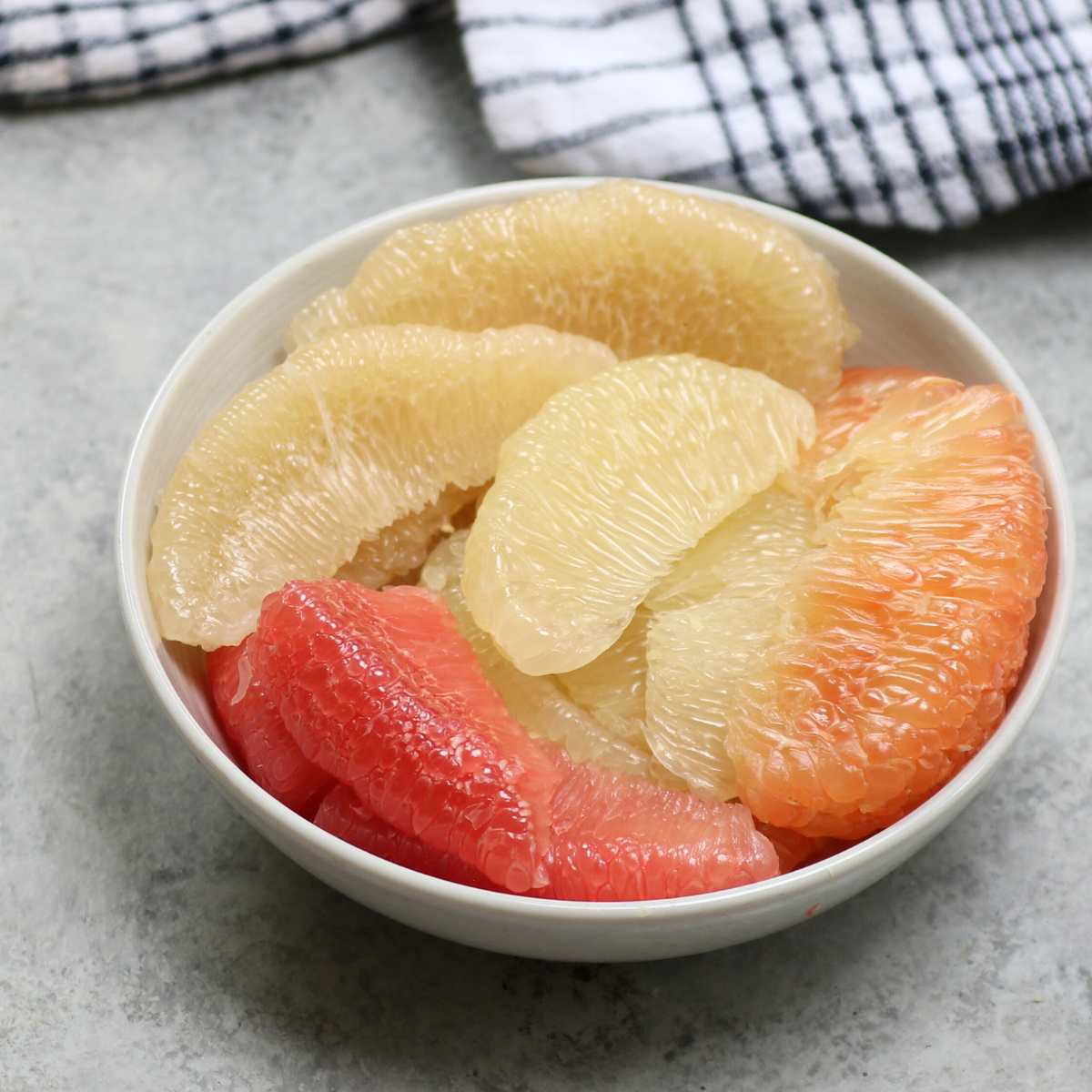
Nutrition and Health Benefits
If you’re wondering whether pomelo is good for you, the answer is basically yes! First of all, it’s a low-calorie food with only 72 calories per cup (USDA). There are benefits for heart health, digestion and disease prevention according to Healthline.
One cup or 190 grams of this fruit contains the following:
- 18 grams of carbs (therefore not keto with 16 grams of net carbs according to Is It Keto.)
- 128% of the recommended daily intake (RDI) of Vitamin C
- 8% of the RDI of dietary fiber with 2 grams of mostly insoluble fiber
- 10% of the RDI of copper
- 9% of the RDI of potassium
- 5% of the RDI of thiamine
- 4% of the RDI of riboflavin
- Smaller amounts of lycopene and other minerals
One of the other benefits? It’s filling so you’ll feel satisfied after eating some. In fact, one fruit is often enough for two people to share.
One small word of caution. Pomelo contains furanocoumarins, which can interfere with the metabolism of statins according to WebMD, so check with your doctor if you take statins.
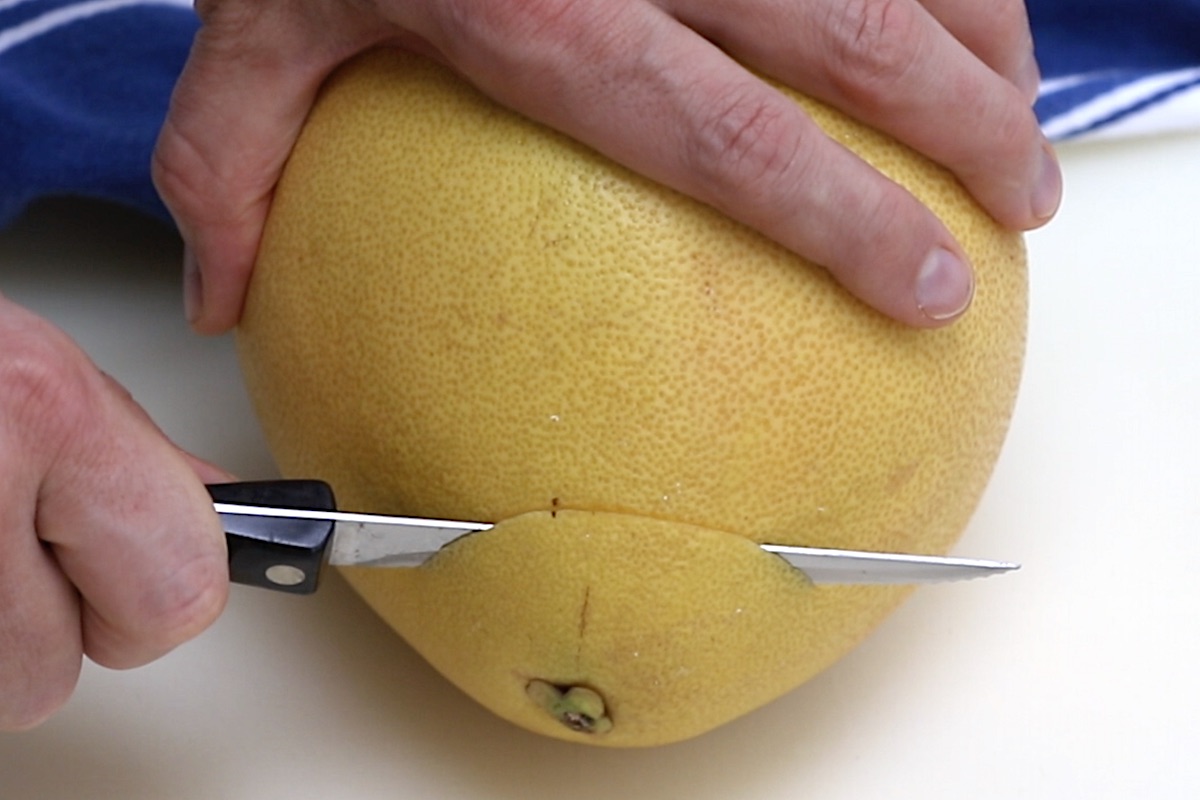
Cutting and Eating a Pomelo
This fruit has the thickest skin of all citrus, so I suggest using a knife instead of your fingers to remove the peel when possible. Start by slicing oner inch off the stem end (the narrow end). That may seem like a lot, but you won’t cut into the flesh.
Next, score the peel a half-inch deep from top to bottom, creating 6 to 8 sections. Using your fingertips, peel back the skin to expose the flesh:
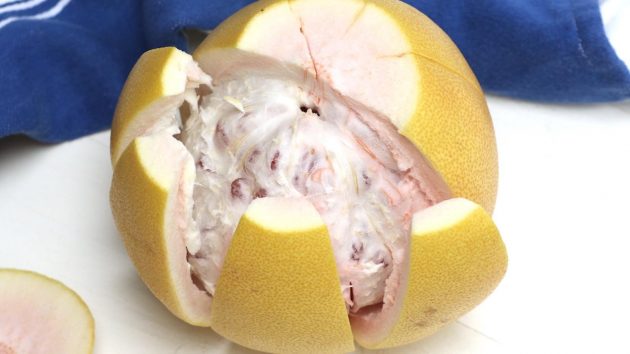
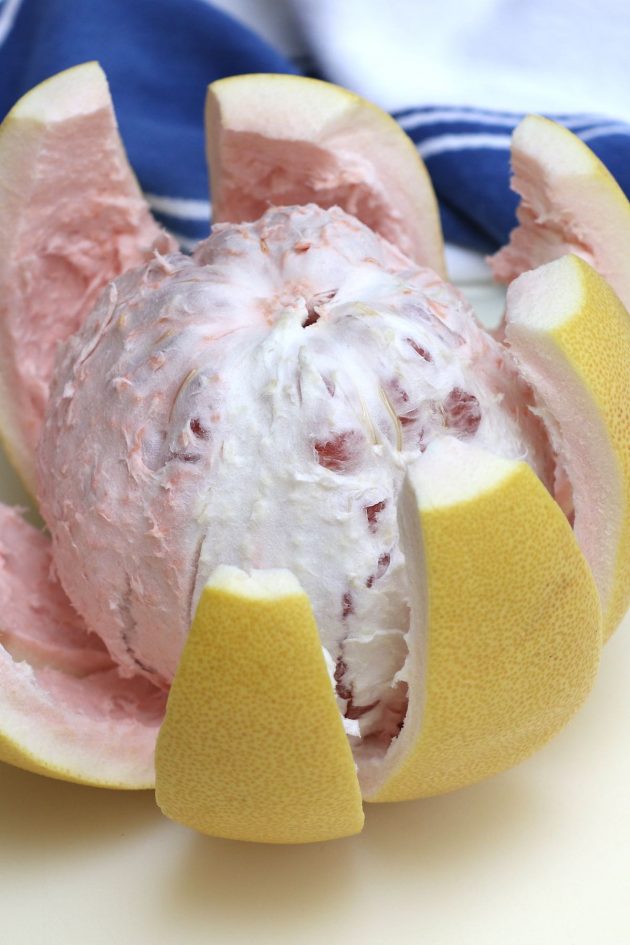
Now you can easily pull apart the flesh into sections or pieces. Since it is not juicy, you don’t need to worry about getting squirted like with grapefruit!
Simply peel back the skin to expose the flesh. You’ll notice a lot of white pith that is best to remove with your fingers and discard. You’ll find it easy to break the flesh into pieces without much mess, since there’s almost no juice. As a result, it makes an easy snack snack, either at home or on-the-go.
Buying and Storage Tips
You can find pomelos in many supermarkets and most Asian grocers. They tend to be freshest when in season locally from November through March. A fresh pomelo will feel very firm and heavy for its size. The skin can be any color and some blemishes are fine, as long as the surface is not soft or squishy.
Sometimes a pummelo will look fine on the outside, but be dry and sour-tasting on the inside. This frustrating situation indicates the fruit is aging and you should find a new supply!
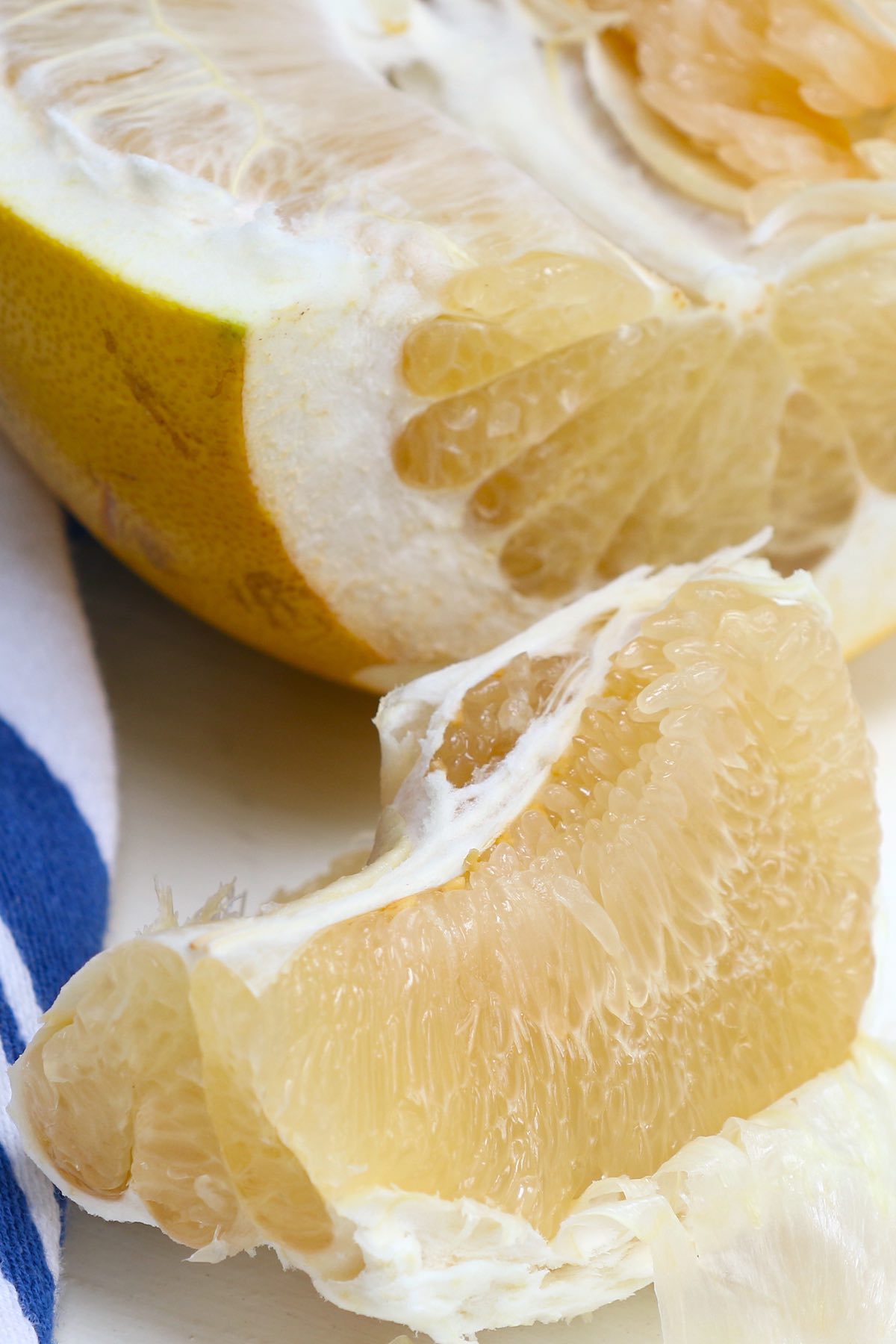
Florida Pomelos: If you can’t find any locally, why not support American growers by buying online from the grove? They arrive at your doorstep super-fresh directly from the Sunshine State!
Storing a Pomelo: You can store a pomelo for up to 2 weeks at room temperature or up to 3 weeks in the refrigerator. Always remove the pith from the flesh before storing. You can also freeze it for up to 3 months for use in smoothies only, as the texture deteriorates in the freezer.
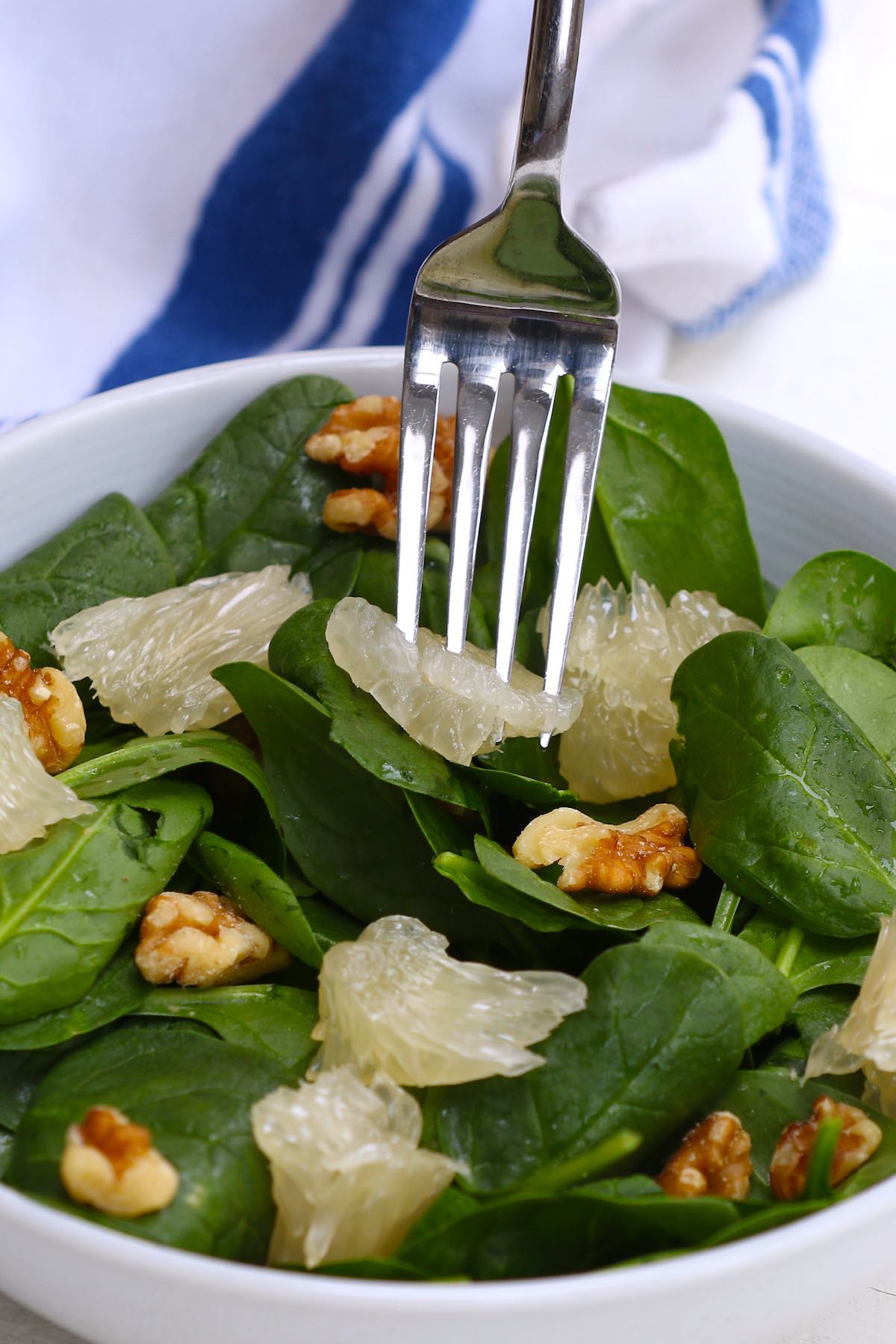
Favorite Pomelo Recipes
Did you know you can use this fruit in recipes too? Here are some of our faves:
- Mango Pomelo Sago: This chilled pudding uses fresh mango, coconut milk and tapioca pearls to make a refreshing dessert. Check out the recipe.
- Thai Pomelo Salad (Yum Som O): This spicy salad has coconut, pomelo, peanuts and shrimp with a spicy dressing with this recipe.
- Pomelo Cocktail: You can make cocktails using this recipe.
- Pomelo Marmalade: Yes, it’s a thing and easy to make too with this recipe.
You May Also Like:
Watch Video:
How to Cut a Pomelo (+ Pomelo Salad)
Ingredients
- 1 pomelo fruit
Pomelo Salad (optional)
- 3 cups baby spinach leaves, packed
- 1/2 cup walnuts, or pecans
- 1/2 cup feta cheese, crumbled (or similar cheese)
- 2 tablespoons balsamic vinegar
- 2 tablespoons extra virgin olive oil
Instructions
Cut and Peel the Pomelo
- Slicing an inch off the top of the pomelo.
- Score the peel about a half-inch deep from top to bottom, creating 6 to 8 sections.
- Separate the peel sections from the flesh using your fingertips. Then remove the pith to expose the flesh.
- Tear the flesh roughly into 1-inch pieces. Set aside.
Make the Salad (optional)
- Rinse the spinach leaves thoroughly. Dry using a salad spinner or paper towels.
- In a salad bowl, add the spinach, walnuts and feta cheese.
- Combine the balsamic and olive oil in a large cup. Whisk vigorously for 30 seconds to form an emulsion. Then pour over the salad, tossing to coat evenly.
- Garnish the salad with the pomelo pieces. Serve immediately.
Equipment
Notes
- Storage: Cut pomelo will last for up to 2 days in an airtight container in the fridge. Remove all pith prior to storing, as it will dry out. You can store the undressed salad for a similar amount of time.
Please read our nutrition disclaimer.
© TIPBUZZ. Images and text on this website are copyright protected. Please do not post or republish without permission. If you want to republish this recipe, please link back to this post. This post may contain affiliate links. Read the disclosure policy here.








I tried your suggestion of putting it on a salad and was yummy! thanks
Hi Beth, Great to hear that and thanks for letting me know. Glad you enjoyed!